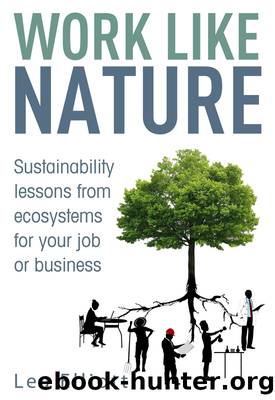Work Like Nature by Lea Elliott

Author:Lea Elliott [Lea Elliott]
Language: eng
Format: epub
Publisher: leanpub.com
Published: 2016-06-06T00:00:00+00:00
Finding a use for rejected produce
Remember back in Chapter 3 when we met those wriggling larvae that Andrew Vickerson, Enterra Feed’s Chief Technology Officer, is raising as a more optimal food for farmed fish? Let’s head back to Enterra’s warehouse to look at an example of biological upcycling.
When I toured the operation, the fly larvae weren’t the only things that had me shuddering. As the door from the dark alley to Enterra crept open, I was hit with the sweet smell of fermentation, as though I’d stuck my head in a bucket of rotting veggies. This scent rises from the larvae’s next meal.
On the warehouse floor, parallel rows of plastic green bins stand at attention like an army regiment awaiting inspection. Enterra regularly collects these waste-filled bins from local food vendors. They round up a smorgasbord of untouched vegetables, funny-looking fruits and stale bread from grocery stores, food processors and restaurants. Enterra is paid to take the food waste away. They only take untouched food, such as expired yogurt, stale buns and damaged fruit, and not other compost, like your kids’ sandwich crusts, watermelon rinds, or nibbled Brussels sprouts.
“A unique feature of our business is that we get paid for our inputs and paid for our outputs,” said Andrew Vickerson. In 2015, Metro Vancouver banned organic waste from its landfills. This ban helped create a market for food waste. Food processors and retailers could either pay Metro Vancouver to turn their food waste into soil or they could find an alternative upcycle option, like Enterra. Part of Enterra’s draw is that food waste providers don’t need to separate food from its packaging.
Just behind the lines of green bins, a truck-sized contraption towers above us. Each day the collected food waste is dumped into the machine, which separates the packaging from the food. The plastic is recycled and Vickerson blends the food waste into smoothies for his black soldier fly larvae.
Enterra’s ravenous larvae eat up to 36,000 tonnes of food waste each year. That’s enough food to fill 2,600 garbage trucks. I wasn’t surprised that there’s ample food waste for Enterra. Fresh food has a limited shelf life, and at least a portion of it will inevitably be wasted. I was surprised though that Enterra’s intake only represents 2 percent of the pre-consumer food waste in Metro Vancouver. Using 2005 federal statistics data, one study estimated that half of the region’s fresh food was wasted before making it to consumers. That’s more than 1.5 million tonnes, or 110,000 garbage trucks, of fresh food wasted before it’s even sold.
Download
This site does not store any files on its server. We only index and link to content provided by other sites. Please contact the content providers to delete copyright contents if any and email us, we'll remove relevant links or contents immediately.
Bad Blood by John Carreyrou(5770)
Principles: Life and Work by Ray Dalio(5323)
Rich Dad Poor Dad by Robert T. Kiyosaki(5150)
Management Strategies for the Cloud Revolution: How Cloud Computing Is Transforming Business and Why You Can't Afford to Be Left Behind by Charles Babcock(4131)
The Confidence Code by Katty Kay(3567)
Thinking in Bets by Annie Duke(3533)
American Kingpin by Nick Bilton(2972)
Playing to Win_ How Strategy Really Works by A.G. Lafley & Roger L. Martin(2959)
Delivering Happiness by Tony Hsieh(2922)
Project Animal Farm: An Accidental Journey into the Secret World of Farming and the Truth About Our Food by Sonia Faruqi(2661)
Brotopia by Emily Chang(2592)
I Live in the Future & Here's How It Works by Nick Bilton(2526)
Mastering Bitcoin: Programming the Open Blockchain by Andreas M. Antonopoulos(2512)
The Content Trap by Bharat Anand(2493)
The Power of Habit by Charles Duhigg(2489)
The Marketing Plan Handbook: Develop Big-Picture Marketing Plans for Pennies on the Dollar by Robert W. Bly(2414)
The Tyranny of Metrics by Jerry Z. Muller(2401)
Building a StoryBrand by Donald Miller(2362)
Applied Empathy by Michael Ventura(2330)
